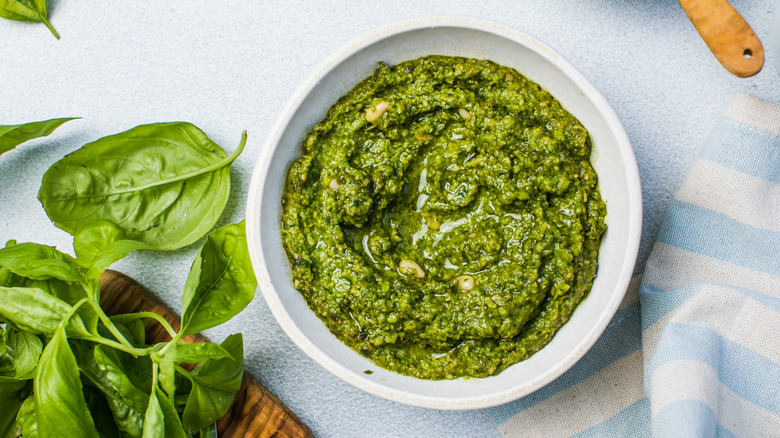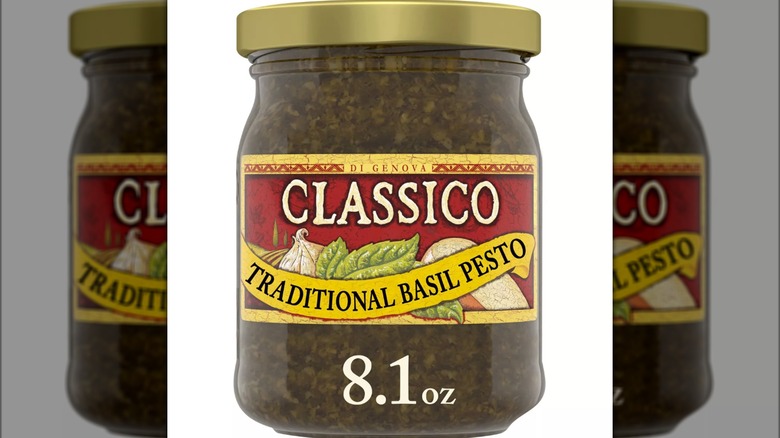Our Least Favorite Store-Bought Pesto Is Anything But Traditional
Tasting Table ranked 11 store-bought jarred pesto brands, and Classico Traditional Basil Pesto came in last place. Allow us to explain our decision. At first glance, it looks like totally normal pesto, and an 8.1-ounce jar runs for $4.99 at a Target in Brooklyn, NY. Word ... right? Look a little closer. The word "traditional" may be on the jar, but there's nothing to this label beyond a marketing strategy targeting an old-world appeal. For starters, the main oil in Classico Traditional Basil Pesto is soybean, not olive oil.
Basil pesto (aka pesto alla genovese) is a timeless, straightforward combination of pine nuts, basil, parmesan, garlic, salt, and olive oil. The pine nuts are roasted, pureed with the remaining ingredients into a smooth paste, and that's it. You can use a non-dairy parmesan substitute to make it vegan. You can even hand-mash it in a mortar and pestle. What you cannot do is skimp on the olive oil. After the basil, it's arguably the most quintessential ingredient in the herbaceous Italian spread — and Classico's version puts it in the backseat. Far behind soybean oil, poor neglected olive oil gets fifth-place billing on the ingredients list (not on our watch, pal).
Cooking oils are not interchangeable, but especially not in such a stripped-down spread as pesto where the ingredients do the heavy-lifting. Pesto doesn't even require cooking, so there's nothing for sub-par substitutions to hide behind. That's why we're passing up Classico for other brands that actually keep it classic.
When it comes to pesto, olive oil is anything but optional
Thinner, yellow soybean oil compared to luscious, thicker, green olive oil makes a huge difference in flavor, texture, and performance when you're using pesto in the kitchen. Soybean oil's flavor neutrality and odorlessness makes it a good fit for dishes that need a moisture or fat component that won't influence the overall profile. Pesto is not one of these dishes.
Pesto wants a flavor boost, and soybean oil cannot provide that. If anything, soybean oil presents a subtle beany flavor, which doesn't complement pesto anywhere near what earthy, vegetal, grassy, peppery, distinctive, aromatic extra virgin olive oil brings to the literal and proverbial table. It's the same reason why you might dress a salad with a drizzle of high-quality olive oil, but not with soybean oil. Don't get it twisted, this isn't a soybean oil smear (pun intended). Soybean oil belongs behind the scenes — in fact, it functions beautifully as a supporting character for frying, cooking, or baking — it just doesn't belong in pesto.
Next time you're browsing the pesto aisle, opt for a brand that champions olive oil the way proper pesto should; DeLallo Traditional Basil Simply Pesto is our favorite. Or skip the trip to the store altogether and whip up a batch of homemade pesto in under 10 minutes. As long as there's buttery, rounded olive oil in the mix, you'll be rollin' ... or should we say spreadin'.

